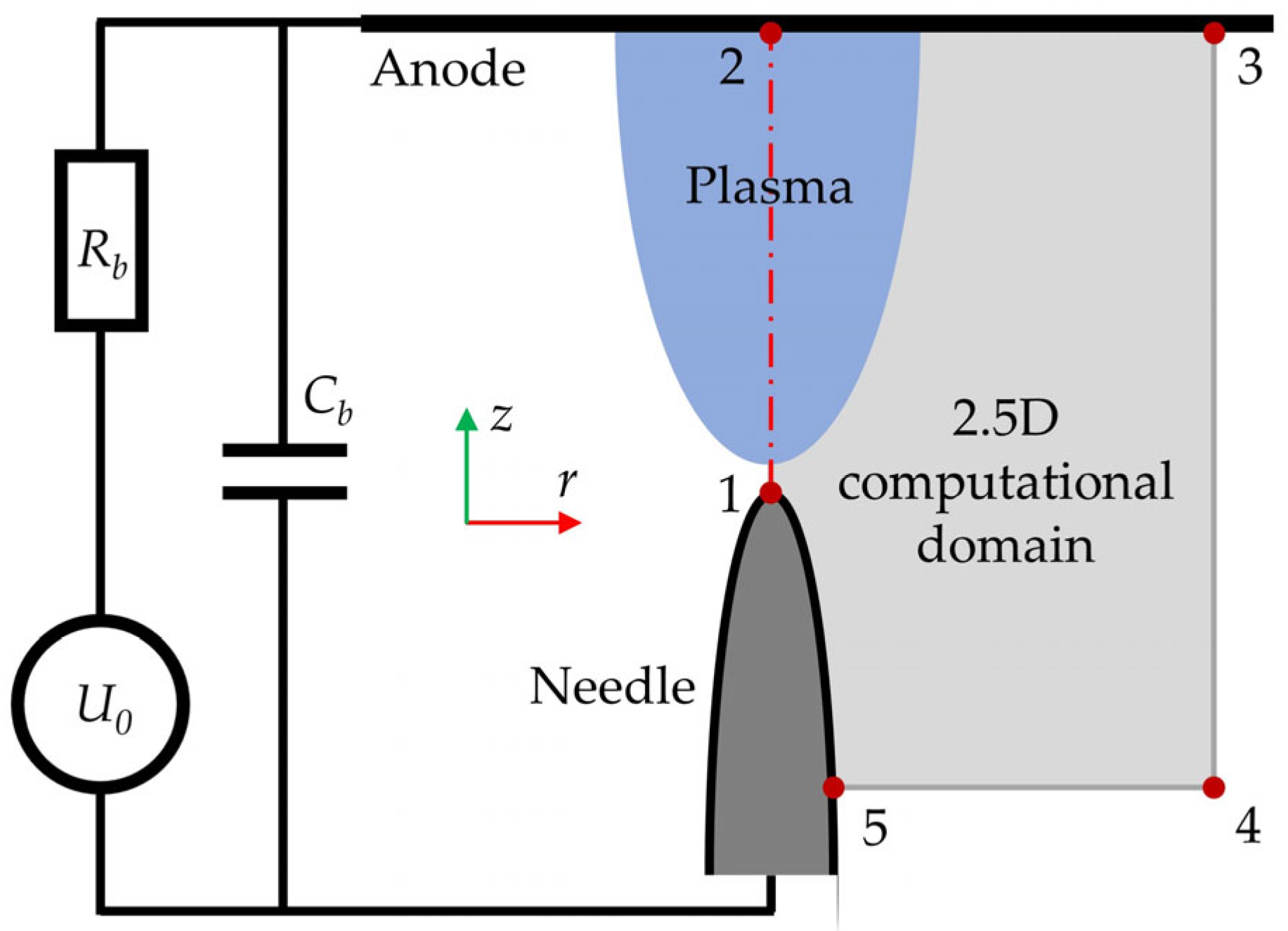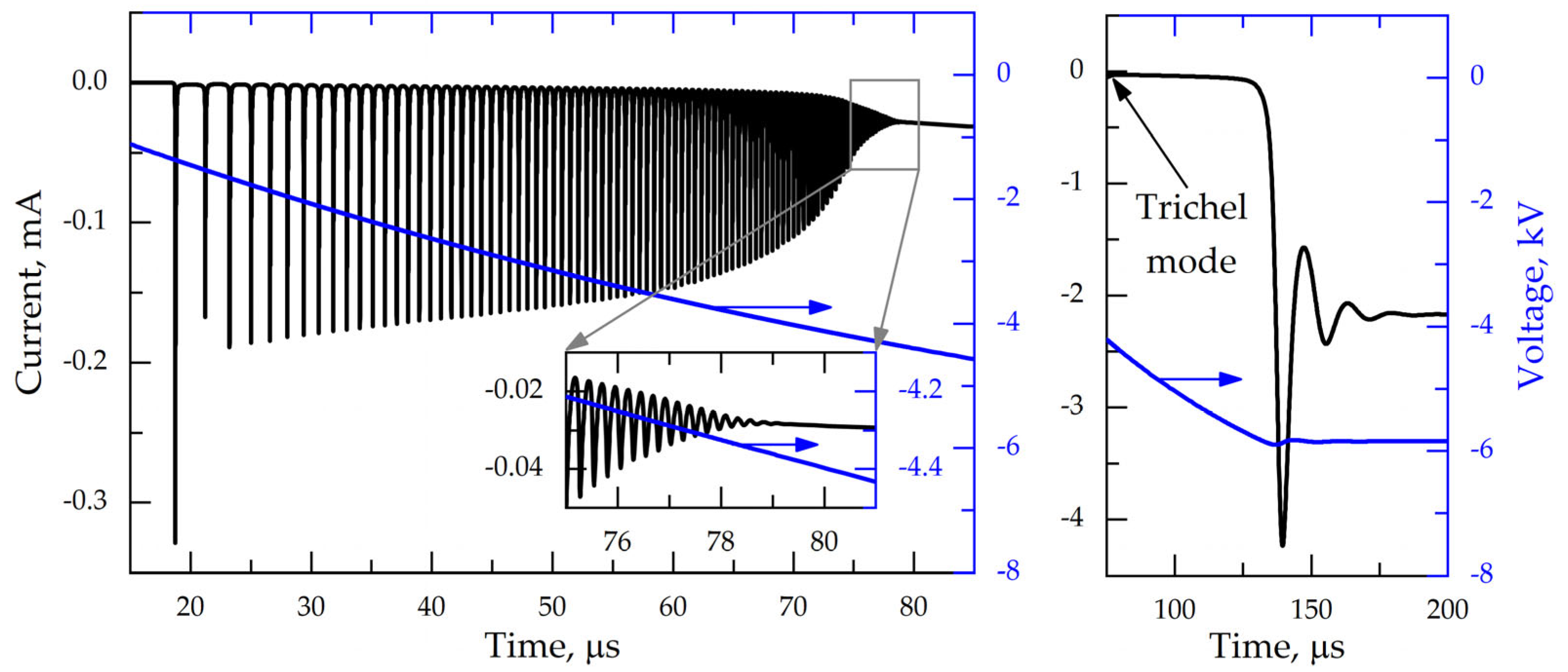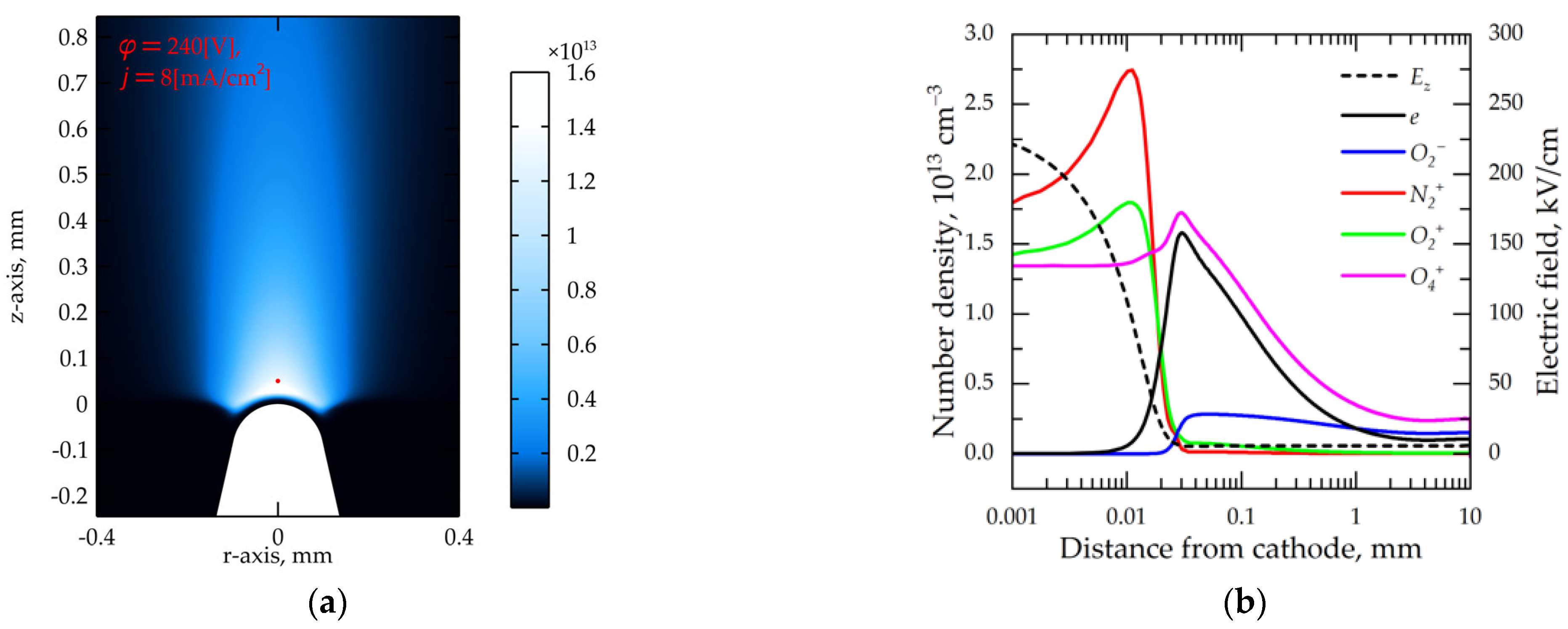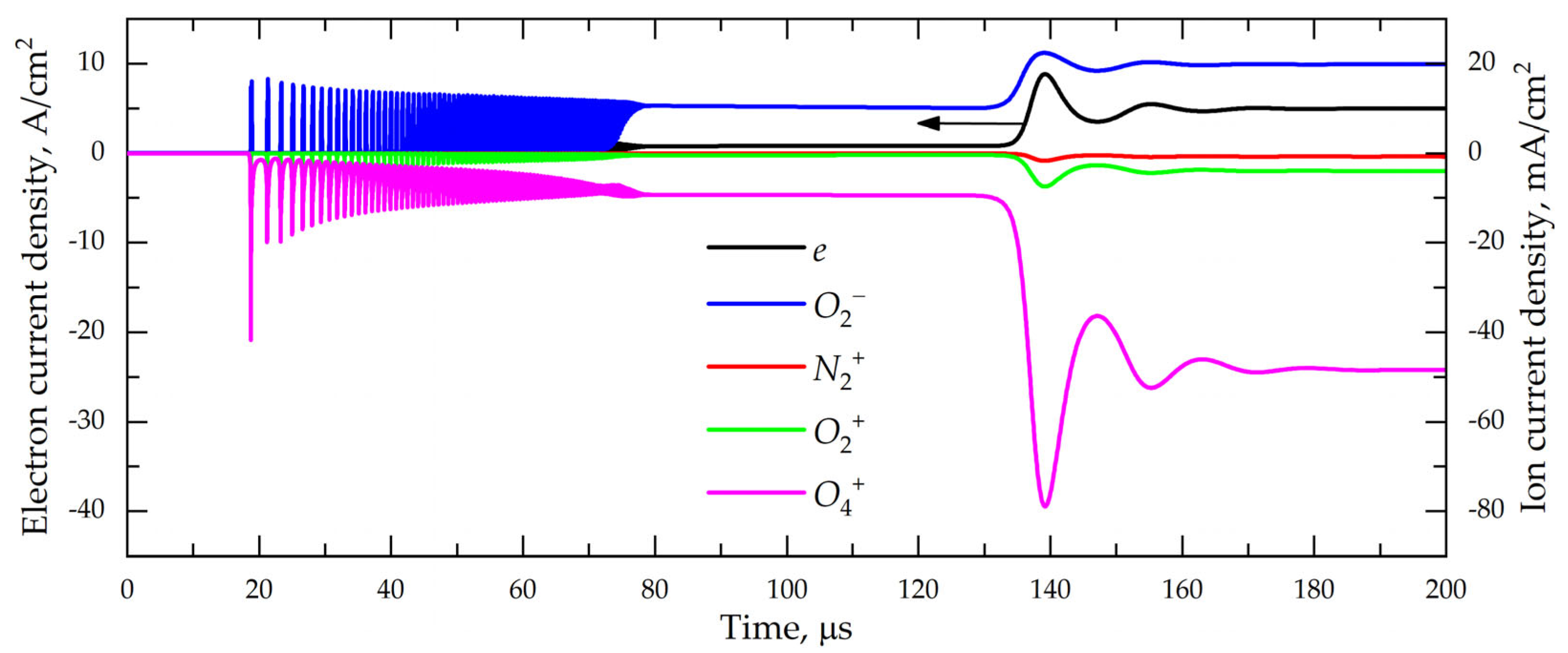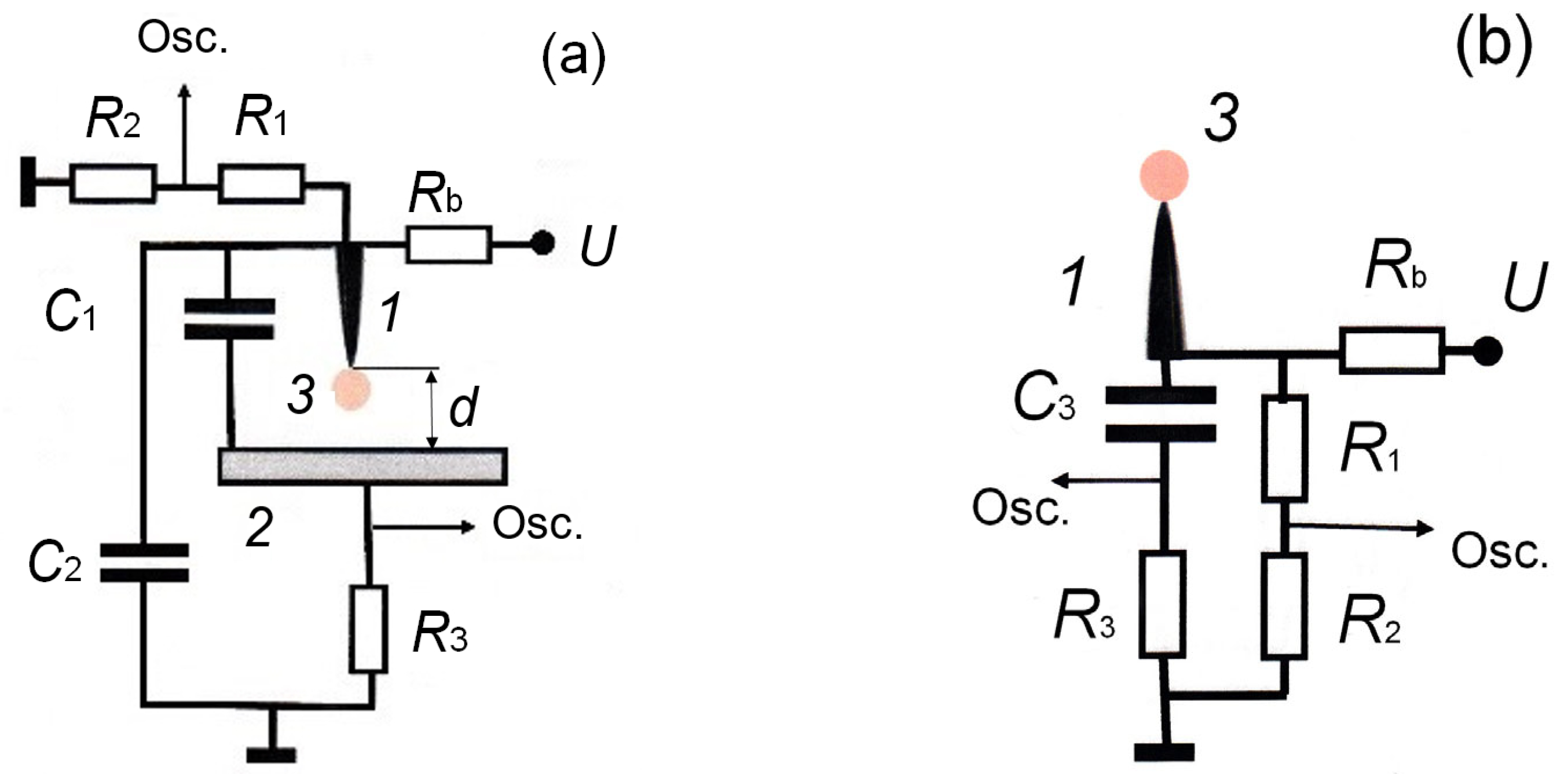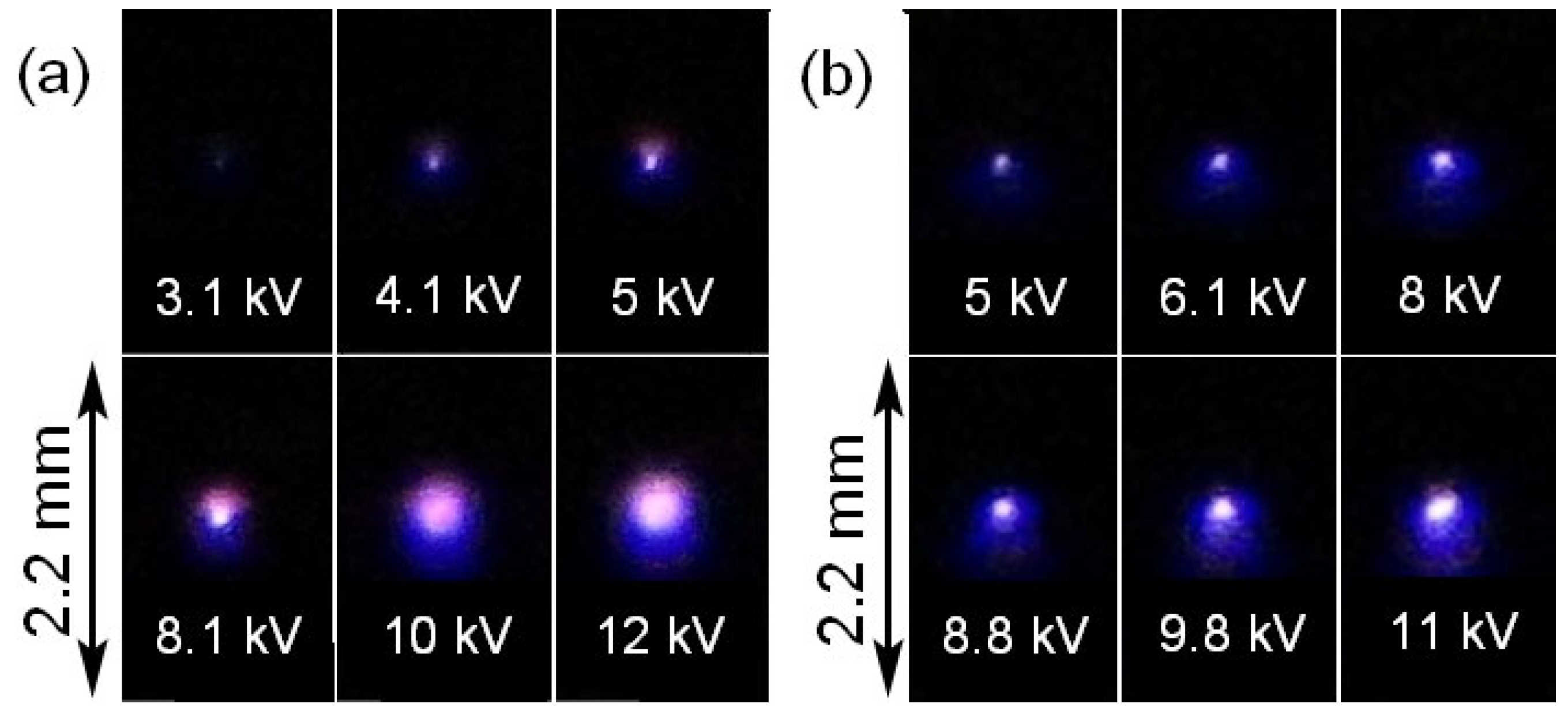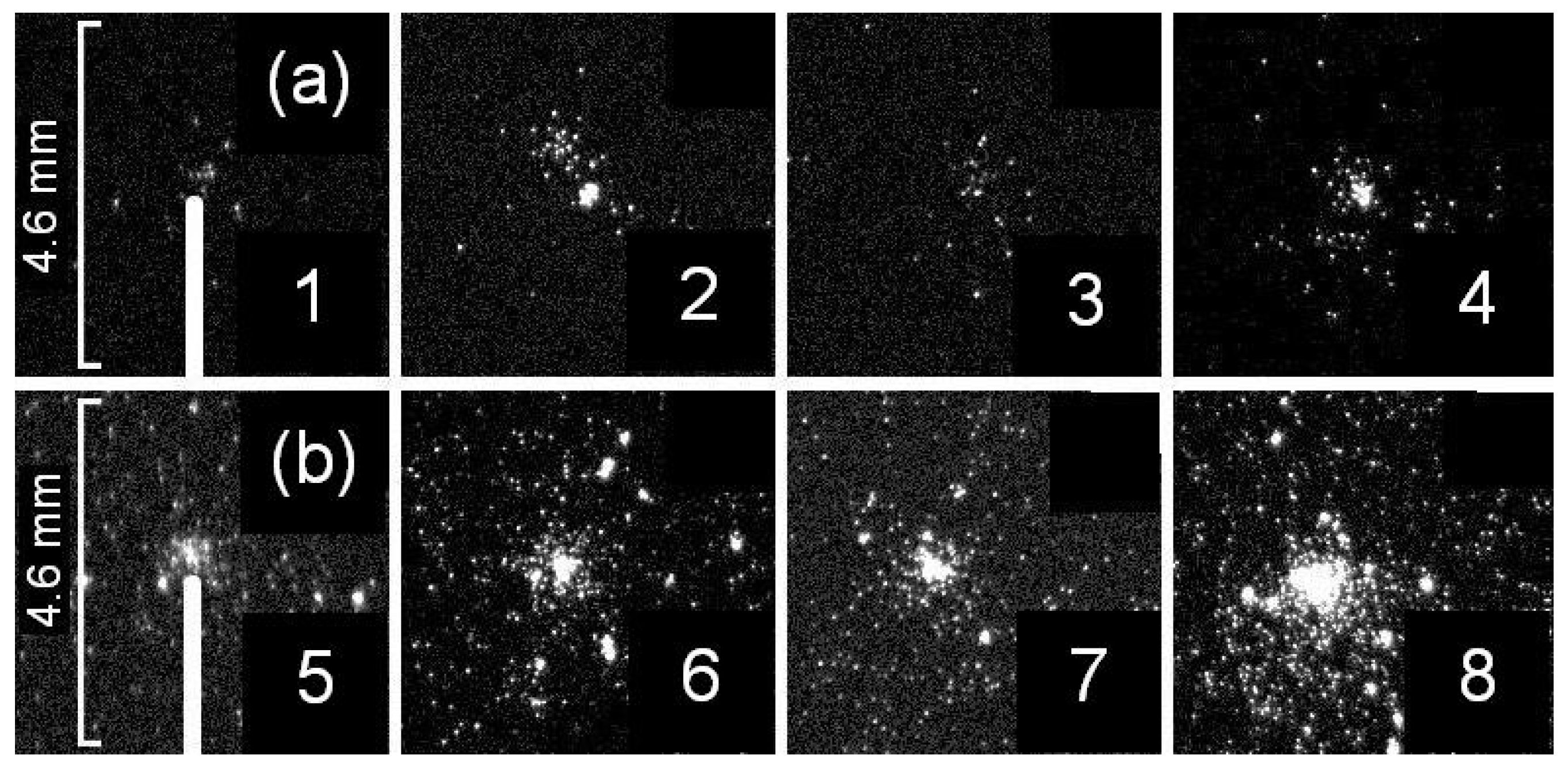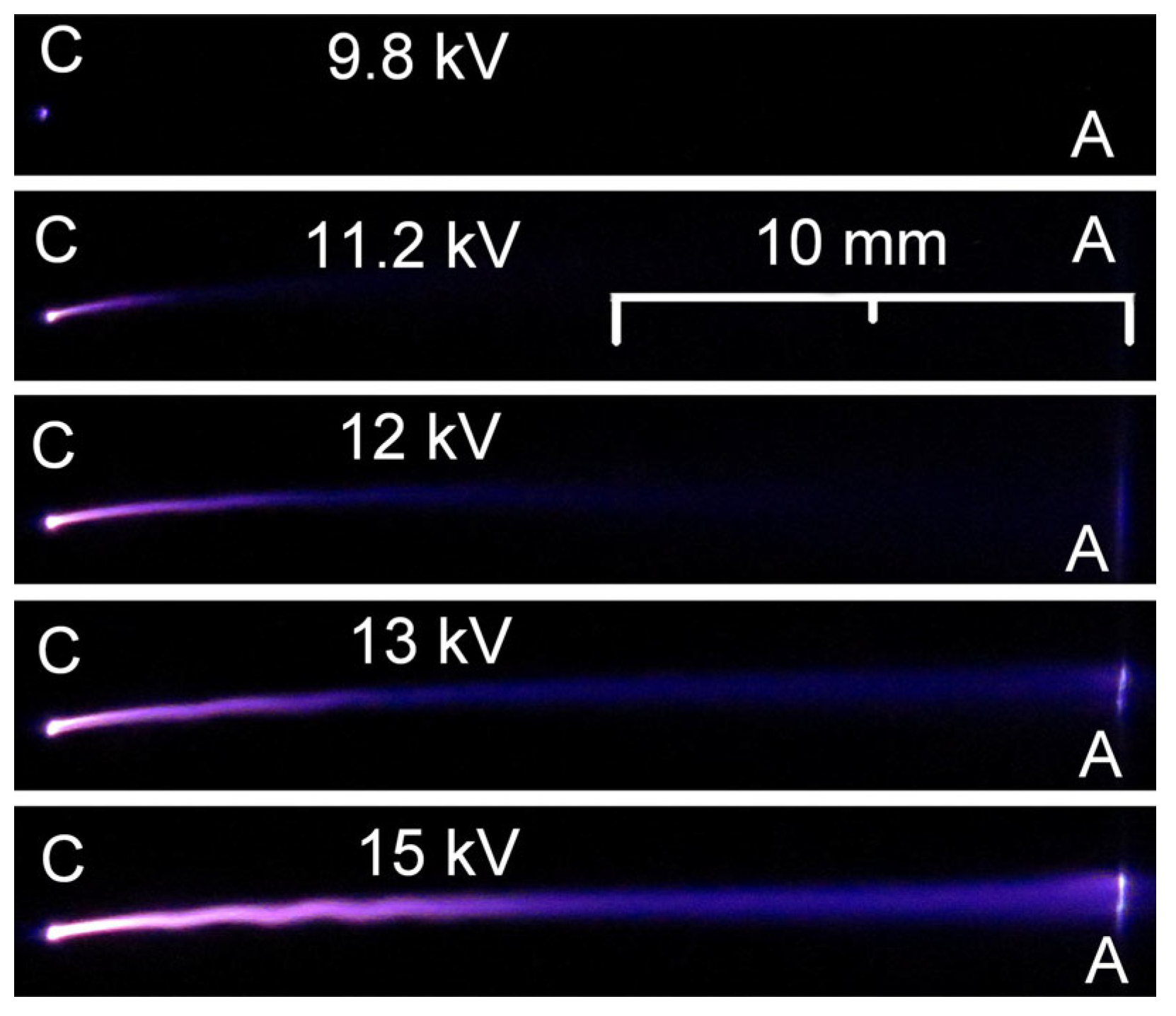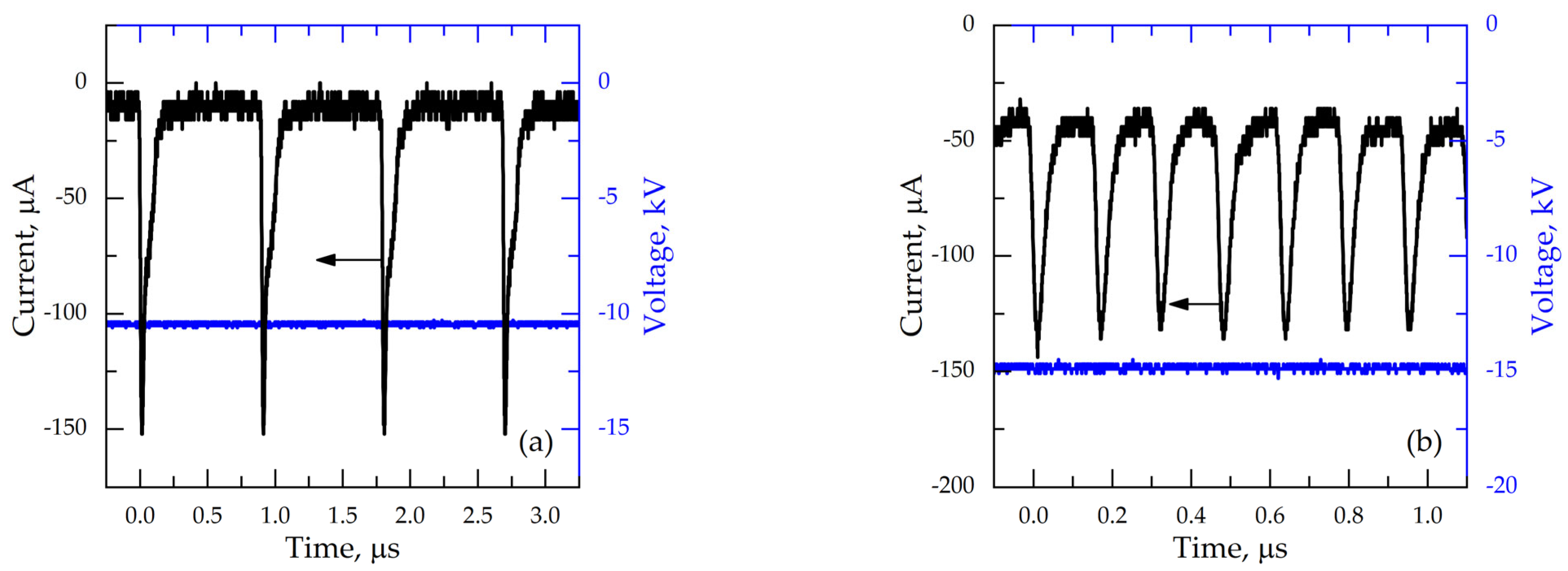1. Introduction
Self-sustained air corona discharge is one of the most common types of electric discharge used in technology [
1,
2,
3,
4]. That is due to the simplicity of technical implementation and a wide range of possible applications as a source of atmospheric ions, reactive radicals, excited molecules and ionizing ultraviolet radiation, electrostatic precipitators for air purification from harmful impurities, etc. Despite the extensive history of corona discharge research [
1,
2,
3,
4,
5] and the substantial number of recent publications, numerous unresolved issues necessitate further investigation. Since corona discharge in atmospheric air has profound prospects in technical applications (indoor ionizers, processing of biological objects, sterilization of surfaces and tools), corona in air is receiving increasing attention from researchers [
6,
7,
8]. In nature, a corona discharge ignites on sharp edges at high electric field strengths in a thunderstorm atmosphere [
9,
10,
11].
Well-known papers describe dozens of models of corona discharge, which made it possible to study its properties in various gases at negative and positive polarity of an electrode with a small radius of curvature. One of the issues of great interest is the physical nature of Trichel pulses: see, for example [
1,
3,
12,
13,
14,
15,
16,
17,
18,
19,
20,
21,
22,
23,
24]. The pulses arise when a corona discharge is ignited with a negative polarity voltage at the needle and continues with increasing frequency as the voltage across the gap increases. The amplitude of the Trichel pulses decreases in relation to the stationary stage of the corona current as the voltage increases, while the magnitude of the corona current between pulses increases [
7].
A feature of Trichel pulses in an electronegative gas is the rapid increase of the current through the gap and the presence of a step on the leading edge of the current pulse [
21,
23,
25]. The first physical models explaining the rapid current increase in Trichel pulses were proposed in [
3,
19,
20]. According to [
19], the first electron initiated from the cathode due to field emission or bombardment by a positive ion forms a primary avalanche due to Townsend ionization. Secondary avalanches are initiated from the cathode due to photoionization. However, as shown in [
20,
23], this mechanism could not provide the rise time of the Trichel pulse current of ~1 ns, which was obtained in [
21,
23,
25].
The Loeb theory [
1,
19] was extended by Aleksandrov [
20]. Based on analysis, it was shown that a large number of electron avalanches are formed simultaneously due to photoionization. It was also proposed that there is an initial stage of the discharge with a duration of ~500 ns with a slow increase in current up to the value from which the Trichel pulse occurs. That could explain the short current rise time duration at a level of ~10 ns. However, the model did not explain the formation of a sequence of Trichel pulses and their disappearance with increasing voltage.
Morrow [
26,
27] suggested that the step on the leading edge of the Trichel pulse is due to the processes of electron emission from the cathode. At the initial current growth, the emission is determined by prompt photons from the discharge plasma, then the main contribution to the electron emission from the same part of the cathode is made by positive ions.
A study of the role of electron photoemission from the cathode revealed its effect on the step on the leading edge of the current pulse in pure oxygen at atmospheric pressure [
23]. In that work, it is assumed that Trichel pulses in case of negative corona are associated with the development of a cathode-directed streamer in the immediate vicinity of the needle tip and the formation of a glow discharge after the streamer arrives at the cathode. In the review [
28], based on analysis and simulation, the hypothesis of [
23] was supported, according to which Trichel pulses are due to the formation of positive streamers in the immediate vicinity of the cathode. However, this model did not explain the formation of the pulse sequence and its disappearance with increasing voltage.
The formation of the Trichel pulse sequence was obtained in the model developed in [
29], and the previous results of these authors were published in [
22,
24]. It followed from the calculations that, during the pulse time, a significant change in the transverse structure of the discharge occurs, and the current growth is ensured by filling the cathode surface with plasma.
As follows from the analysis of the most cited works, the proposed physical models describing the formation of Trichel pulses differ significantly. The parameters and modes of Trichel pulses generation obtained in various experimental studies also differ. Therefore, deeper and more comprehensive studies of this regime of corona discharge are required. Moreover, for adequate theoretical modeling of multivariate gas-discharge processes occurring in small volumes and in short times, it is necessary to use modern computational algorithms that require large memory and computation time.
The review summarizes the theoretical and experimental data obtained in recent years by the authors of the review [
7,
15,
17,
30] and also compares them with data from other scientific groups. The main part of the review consists of sections with data obtained by theoretical modeling (
Section 2 and
Section 3) and experimental studies (
Section 4 and
Section 5), which describe the key modes during the ignition and maintenance of a corona discharge, as well as its transition to other forms of discharges.
In this review, we generally confine ourselves to a detailed consideration of the corona discharge with the negative polarity of the pointed electrode, leaving aside for various reasons the “positive corona” for a separate analysis. For those interested in a discharge with a positive needle, we suggest as a good work [
31]; you can also find data in our experimental works; see, for example, [
7]. Since the development of several parallel filaments from the needle, which has a radius of curvature of more than 100 μm, can affect the modes of a corona discharge and its properties [
16], this review considers the experimental results and processes during the ignition of a single “elementary” corona discharge from the needle with a radius of curvature about 100 μm or less. In this case, one elementary filament of the corona discharge is formed, which enhances to determine its key modes more accurately. It is easy to perform this in calculations by setting certain conditions in the model used under which a single corona discharge is formed.
Thus, the aim of this review is to analyze the physical processes responsible for the occurrence of a corona discharge and its development, to present the main experimental data on the electrical and optical characteristics of a corona discharge in atmospheric pressure air, and also, to consider the conditions for the transition of a corona discharge to other modes of self-sustained discharges.
The analysis is based on the authors’ theoretical modeling of a corona-streamer discharge [
15], since it revealed four sequential burning modes. These are (1) the “dark mode” of the breakdown delay; (2) the “mode of the Trichel pulse” with a variable duty cycle and a quasi-stationary component of the corona current; (3) an “intermediate mode” of a growing weak current, culminating in an oscillatory transition to (4), a “stationary mode”, which has the structure of a classical glow discharge. The same modes were implemented in the experiments of the authors.
3. Non–Stationary Dynamics of Corona Discharge
3.1. Discharge with Current Limitation by Ballast Resistance
Let us consider in detail the basic regularities of the corona discharge dynamics using a particular example, which demonstrates the main characteristics of negative corona on a specific example. The parameters of the discharge circuit and the geometrical characteristics of the diode, taken below in our calculations, are typical for corona technical applications. The radius of curvature of the needle cathode is assumed to be 100 μm (this is a typical value for technical devices, since sharper tips are quickly smoothed out during discharge burning due to electrode erosion, and less sharp ones require increased voltages to initiate a corona). The distance from the needle cathode to the plane anode is equal to d = 10 mm. Since the typical voltage values in corona–discharge devices for such gaps fall in the range 5–30 kV (depending on the purpose of the discharge), for the calculation below, we have chosen the external source voltage value closer to the lower limit of this range: U0 = −8 kV.
The ballast capacitance Cb = 100 pF is connected in parallel to the diode (such capacitance in real circuits is inevitable as the interelectrode capacitance of the diode, but in technical devices, it can be implemented as a separate capacitor). The current–limiting ballast resistance in this example is set to Rb = 1.0 MΩ, which limits the stationary discharge current in the circuit to the milliampere level (this is a typical value for the corona discharge devices to prevent an electrical fault in the circuit and irreversible destruction of the device).
Figure 2 shows the calculated time profiles of the discharge current
I and the diode voltage
Ud. Due to the large ballast capacity and resistance, the diode voltage slowly increases (time constant
RbCb = 100 μs), and the corona discharge sequentially passes through the four distinct stages. They are well identified on the discharge current time profile in the time range of 0 to 200 μs.
3.2. Dark Discharge Mode (DDM) of Breakdown Delay
The first stage, which can be called pre-breakdown (or “dark” phase, since the discharge glow is not experimentally observed due to the low brightness level), is characterized by an increase in the diode voltage from zero to about U1 = 1500 V. The duration of this stage is τ1, which is easy to estimate from the expression U1 = U0·τ1/RbCb, which can be called the breakdown delay time.
In our calculations (
Figure 2), this stage takes place in the time range from 0 to the 19th microsecond. At this stage, the initiating and emitted electrons generate exponentially near the needle tip, starting with single electrons emitted on the surface of the needle cathode. By the end of this stage, the number density of charged particles even near the tip of the needle cathode does not exceed 10
8 cm
−3, and the space charge does not distort the electric field yet. Certainly, the space charge begins to distort increasingly the electric field with time, triggering positive feedback and providing a rapid local increase in plasma density, which is manifested as a sharp surge of the discharge current. This pulse indicates the transition to the next stage of the corona discharge.
3.3. Frequency Mode of Trichel Pulses
The second stage begins with a rapid increase in the plasma density at the tip of the needle cathode and the formation of the first current pulse, followed by a pulse-frequency sequence of Trichel pulses [
1,
2,
3,
7,
8,
12,
13,
14,
15,
16,
17]. In the interpulse period, a “background current” occurs with increasing magnitude with time.
The first pulse is of particular interest, and its parameters differ significantly from the parameters of all subsequent pulses. So, the first pulse has maximum amplitude. The physical processes responsible for the formation of the first current pulse are studied in detail in the works of the authors [
17,
30].
In the case of the strong limitation of the discharge current by the ballast resistance, the gap voltage gradually increases, and, as a result, the parameters of the Trichel pulse mode also drift, as shown in
Figure 3. The amplitudes and durations of the current pulses are weakly dependent on the source voltage, smoothly changing with the diode voltage.
Figure 4 shows the current time profile of the 5th pulse and the corresponding spatial axial distributions of electron number density at different time instances, marked with dots on the current profile. It can be observed that the maximum number density near the tip varies by about four orders of magnitude: from 3 × 10
9 in the interpulse interval to 3 × 10
13 cm
−3 at the peak current. It is also seen that the trailing edge of the current pulse is ensured by the rapid dissociation of free electrons at the plasma edge facing the anode.
The trailing edge of the Trichel pulse is related to the disappearance of free electrons and the accumulation of negative ions in the region with a relatively weak electric field. In the interpulse interval, the number density of negative ions gradually decreases due to the divergence of the transport flux, and thermal detachment of electrons occurs in the weak field region and propagates rapidly to the anode. After the decay/departure of negative ions, the electric field near the tip increases again up to ~10 kV/cm, the rate of free electrons and positive ions generation greatly increases, and the sequent Trichel pulse forms. Let us pay attention to the fact that if we excluded from the plasma–chemical model the reactions of electron detachment, the subsequent pulses would not appear! As an indirect confirmation of the above-stated point of view on the pulse-periodic mode of the negative corona being able to serve a strongly pronounced effect of the gas electronegativity, in electropositive mixtures (N
2:Ar), the Trichel pulse sequence is not observed [
2].
The amplitudes of the Trichel current pulses gradually decrease (and the pulse durations increase) with an increase in the applied voltage, and gradually fade to zero pulsations. The Trichel pulse repetition rate drifts from (0.7−1.0) × 10
6 pps at the beginning to 4.0 × 10
6 pps by the end of the second evolution stage. Additional studies have shown that the discharge current at the end of the Trichel pulse mode, that is, by the time of transition to the third stage, does not depend on the source voltage and equals 27–29 µA (
Figure 2). Hence, we can draw a cautious conclusion that the termination of the pulsed mode of corona discharge is determined not so much by the applied voltage as by the density of the accumulated plasma near the tip of the needle cathode.
3.4. Intermediate Discharge Mode (IDM) of Monotonous Current Growth
The third stage begins at the damping of the Trichel pulse mode and is characterized by a monotonous increase in the discharge current and ended with a rapid transition to a high-current mode, as one can see in
Figure 2. This stage of the corona discharge is given very little attention in publications if it is mentioned at all. It is this mode that is responsible for the gradual formation of the classical glow discharge structure along the diode axis. By the end of the pulse mode, a plasma density with a monotonic decrease from the tip to the anode is formed in the gap, and the electric field is close to a homogeneous distribution.
The transition from the third stage to the fourth is similar to the “second breakdown” of the gas discharge gap after the gap voltage exceeds the threshold value (in our case, this value is approximately 6.0 kV). Namely, the slow growth of the discharge current from the microampere level abruptly changes on a steep increase by several orders of magnitude, and the transition occurs as a relaxation-damped oscillation (see
Figure 2). This analogy is fully confirmed by calculations of the charged particle’s transport and the electric field evolution: when the field strength reaches the threshold value, an avalanche-like increase in the free electrons density occurs, the space charge of which quickly redistributes the electric field from an approximately uniform distribution in the gap to its enhancement near the cathode, which is specific to a glow discharge.
3.5. Stationary Glow Discharge Mode (GDM)
In the fourth stage, a steady-state stationary structure of the classical glow discharge is established, despite the presence of axial geometry of the gap. The plasma density distribution remains highly non-uniform, which is typical for the corona, as shown in
Figure 5. At this stage, the discharge current is equal to 2.2 mA, and the current density value is 8.0 A/cm
2 at
z = 50 μm on the discharge axis. The plasma potential with respect to the cathode is +240 V, which is typical for a glow discharge in the air [
2].
Note that the increase in the voltage of source U0 affects only the discharge current and almost does not change the discharge burning voltage remaining near the value of 5.9 kV. The electric field distribution is almost uniform along the discharge axis and also does not change (~5.6 kV/cm), although the current density drops significantly due to the decrease of plasma density along the discharge axis towards the anode. This non–obvious fact (the constancy of the burning voltage at a large variation of the discharge current) is due to the fact that the current density at the steady-state stage is determined by processes in the near-cathode region, and the column (in glow discharge, it is called the positive column) plays a low-key role of a conductor, which is sufficient to maintain the plasma conductivity at the low voltage value.
For that reason, it is interesting to compare the obtained parameters of the cathode layer with the known parameters of a normal glow discharge in the atmospheric-pressure air [
2]: the voltage drop is about 270 V (depending on the cathode material), the layer width is about 6 microns, the current density is about 200 A/cm
2. At the steady-state stage, the current density on the axis near the tip needle (8–20 A/cm
2) is ten times lower than the ”normal” one, the width of the cathode layer (2–15 microns) is several times greater than the “normal” one, and the cathode voltage drop (240–280 V) is practically equal to the “normal” values. These divergences from the “normal” parameters show a special (irregular) mode of the cathode layer formation in a stationary corona discharge, clearly due to its highly inhomogeneous geometry.
3.6. Ionic Composition and Mechanism of Charge Transport in Plasma
We can conclude that the theoretical model of the corona discharge formulated above allows us to describe correctly the dynamics of the ionization processes and to obtain a correct estimation of the observed discharge parameters at all stages of its burning. Thus, the theoretical results confirm the experimental studies that the first Trichel pulse has the maximum amplitude of the current, and the amplitude of the second pulse is several times lower than the one of the first pulse.
Based on the plasma chemical scheme (
Table 1), we can perform the detailed calculation of the “partial composition of the discharge current” (
Figure 6), which shows the local dynamics of currents in the plasma near the cathode tip (at a distance of 100 microns from the tip needle). Here, the additional details of the discharge development are visible, in particular, changes in the ion composition of the plasma and the mechanism of charge transport at different stages of the discharge.
Thus, the amplitudes of the ion current are about 200 times smaller than the amplitude of the free electron current. Taking into account the mass ratio , this means that the density of electrons and ions at this stage is commensurate, and the electron–ion plasma can is presented. This ratio of electron and ion densities decreases by about 2 times in the third (quasi-stationary) stage of current transport.
The ratio of currents and densities changes even more noticeably at the stationary (fourth) stage of the discharge. The total ion current density at this stage is about 90 mA/cm
2, and the current density of free electrons is about 5 A/cm
2, which is only ~50 times higher. This means that the density of free electrons in the plasma is several times lower than the concentration of ions, but the plasma conductivity is still provided by electrons. This situation is typical for the air plasma [
41,
42], when its quasi-neutrality is maintained by a balance of positive and negative ions, and current transport is provided by electrons.
4. Experimental Setup Used to Study Corona Discharge (CD)
When conducting corona discharge research, the most commonly used electrode configuration is needle-to-plane. A voltage is applied to the gap at various rates of voltage rise; see [
12,
14,
20,
42]. In our experiments, we employed two setups, as depicted in
Figure 7 and described in references [
7,
15,
17,
30].
In the common setup shown in
Figure 7a (Setup 1), which utilizes the needle-to-plane electrode configuration, a constructive capacitance C
1 was added between needle 1 and plane 2. The current through C
1 was not registered by the shunt. Moreover, an additional capacitor C
2 was included. For an interelectrode gap of 20 mm, the value of C
1 was 3.7 pF. The shunt registered the current through the capacitor C
2, which was formed on one side by the needle and its connection to the ballast resistance R
b, and on the other side, by the plane electrode 2 and the metallic surface of the experimental setup, which was connected to the plane electrode via the shunt R
3 and also connected to the grounded output of the power source. The capacitance C
2 had a value of 5.8 pF. The shunt resistance was 1 kΩ. The voltage applied to the needle-to-plane gap was supplied from the power source through the ballast resistance R
b, which typically had a value of 3 MΩ in most experiments. The voltage pulse rise time to the desired level varied. In the experiments on CD initiation, it was intentionally set to a low value (tens of seconds or more). This allowed for simulating CD initiation under steady-state voltage conditions in the gap and implementing the conditions of the dark discharge mode (DDM). Experiments were also conducted with rapid voltage rise in the gap (tens to hundreds of volts per nanosecond). At the same time, the recording of the volt–ampere characteristics of the CD was accelerated, as well as its transition to other forms. The gap length could vary from 1 to 100 mm. Most of the data were obtained with interelectrode gaps of 5, 10, and 20 mm.
In the second setup depicted in
Figure 7b (Setup 2), a solitary needle was used, which was associated with remote objects through “stay” capacitance (not shown in
Figure 7b). The needle was mounted on a K15-10 ceramic capacitor with a capacity of 4.7 nF. This allowed for the registration of the pulsed component of the CD current. In this setup, the magnitude of the electric field strength,
E, near the needle tip did not change significantly. However, with increasing distance from the needle tip, the electric field strength fell faster, and the current of the stationary CD decreased.
The needle electrode was fabricated from a piece of a “bead” needle 0.32 mm in diameter with a radius of curvature of about 20 μm, which varied insignificantly during the experiments. This stability was achieved using a large ballast resistance and operation in modes without spark breakdown, as well as without switching to the glow discharge mode (GDM). This made it possible to reduce the pulse and average currents of discharges and, thereby, strongly reduced the erosion of the electrode. The stability of the geometrical parameters of the needle can be rapidly controlled in terms of the voltage, ensuring the initiation of the first current pulse of the CD. It is known that the CD ignition voltage increases with the needle tip radius of curvature under the same external conditions (pressure, humidity, and temperature of the air), which is associated with a decrease in the reduced electric field strength. In preliminary experiments, it was found that at
r ≥ 100 μm, several filaments can form near the needle tip, attached to different points of the needle tip, which merge into one when the voltage increases, and a constriction forms at the needle tip. The presence of several attachment points of a CD to a needle negative polarity is described in detail in [
16,
18].
When the power supply voltage increased >8 kV, the air in the gap was purged by a fan. This was done to reduce the effect on the CD of particles that are produced in the region of a high electric field near the needle tip and are carried into the gap due to the electric wind [
43].
The voltage across the discharge gap was measured using an ACA-6039 high-voltage voltage divider with a bandwidth of 50 MHz, and the discharge current was measured by a shunt based on TVO brand resistors. The signals from the shunt and voltage divider were fed to an MDO 3104 oscilloscope (1 GHz, sampling frequency 5 GS/s). At a sampling rate of a long-duration oscilloscope (hundreds of microseconds or more), the bandwidth of the oscilloscope was reduced to 20 MHz. This made it possible to reduce the effect of electromagnetic interference on the signals. Note that when using shunt R3 and the first circuit, both pulsed and stationary components of the CD current were recorded. The second scheme made it possible to register only the impulse component of the current. The discharge glow was photographed using a four-channel HSFC PRO ICCD camera and a SONY A100 camera with spectral sensitivities of a GaAsP photocathode in the 300–900 nm range. The minimal exposure duration of the ICCD camera was 3 ns. Since the energy of one Trichel pulse was very small (~1 µJ and less), it was not possible to obtain data on the dynamics of plasma radiation during the formation of a single pulse. However, when using the ICCD camera, the dimensions of the luminous plasma region near the needle tip were recorded for some Trichel pulses. A similar technique was used in [
14], where the integral image of a corona discharge was photographed using an ICCD camera for 15 or 50 pulses. To obtain color photographs of corona discharge radiation at low voltages of the voltage source, a SONY A100 camera was fixed on a tripod and the shutter speed was tens of seconds.
The emission spectra of a CD were recorded by an HR2000+ES spectrometer (OceanOptics Inc., Dunedin, FL, USA; Δλ = 200–1150 nm and δλinstr ≈ 0.9 nm) with a known spectral sensitivity curve, radiation to which was fed through a P600-1-SR optic fiber. We checked the sensitivity calibration of the spectrometer using sources of spontaneous emission with a SL5 Deuterium/Halogen Combination Lamp, (StellarNet Inc., Tampa, FL, USA); a miniature Deuterium and a halogen light source that covers the 200–1700 nm range.
Experiments carried out by these setups made it possible to obtain new data of the CD and greatly facilitated their interpretation, as well as the comparison of the obtained dependences with the simulation results. When analyzing and comparing the experimental results of various scientific groups, the description of important details is very often missing. Therefore, prompt verification of the received and known data facilitated the preparation and writing of this review.
6. Conclusions
Based on the presented studies and the results of other researchers, it is possible to formulate several reliably established regularities of a corona discharge with a negative polarity of the tip.
(1) The process of a corona discharge formation as the voltage on the diode increases can go through 4 different modes: a dark discharge mode, the mode of Trichel pulses, an intermediate mode of a monotonous increase in current, ending with a “second breakdown”, and passing into the mode of a stationary glow discharge. The Trichel pulse mode is implemented in a limited voltage range (in
Figure 2a, this is a wide range of 1.4–3.9 kV, and in
Figure 15, the range is narrower, 3.0–3.4 kV).
(2) If, according to the conditions of the experiment, the voltage does not rise above the upper limit of this range, then the pulse-periodic Trichel regime can continue indefinitely in time. At a voltage just above this level, the pulsed mode can have a very low repetition rate, down to a few pulses per second. In this case, a pulsed corona discharge can go into a dark mode, and then generate the “next first” corona pulse. This feature during the ignition of a corona discharge was recorded both at the negative and the positive polarity of the tip. The amplitude of the rare “first” Trichel pulses did not change significantly.
Note that the transition stage from the dark mode to the first Trichel pulses, as well as the return to the dark mode between rare current pulses, requires additional experimental and theoretical studies, both for the negative and positive polarity of the tip.
(3) Theoretical simulation showed that the Trichel pulse mode is due to the accumulation of positive ions near the pointed cathode and the rapid increase in the rate of ionization processes when the number density of free electrons reaches a level of ~1011 cm−3. The calculations showed that the maximum current of the first Trichel pulses is realized at an electron number density of ~1013 cm−3, which is typical for electron avalanches in the avalanche–streamer transformation. However, the rapid escape of free electrons from the strong field region and their subsequent recombination and/or attachment does not allow the starting streamer to move toward the anode.
(4) Detailed simulation of the 1st Trichel pulse generation showed [
12] that the lower voltage limit
U1 for triggering the pulsed mode corresponds to the local field strength at the tip at the level of 2-fold static breakdown field strength of the flat gap. For air, it is ~30 kV/(cm × atm). This level of the local field just ensures the formation of the structure and the burning of a self-sustained discharge. To estimate the field strength at the tip, you can use the well-known formula
, which is exact for the “hyperboloid of revolution-plane” geometry. For the conditions of
Figure 2 (
U1 = 1500 V,
d = 1 cm,
rcurv = 0.01 cm), this formula gives an estimate of
Emax = 50 kV/cm, which is approximately twice the static breakdown threshold.
(5) The upper voltage limit
U2 = 5.9 kV corresponds to the situation when stationary plasma can be maintained along the entire length of the gap, which is possible at an average field strength of
Eaver =
U2/d ~ 6 kV/cm. It is this level of field strength (~5 kV/cm × atm) that occurs in the positive column of a glow discharge in the air [
2]. It should be specially emphasized that the current density of a stationary glow discharge mode in the tip–plane configuration is very far from the parameters of the classical “normal glow discharge” in the plane-parallel geometry.
If the voltage across the diode can provide an average field significantly higher than this level, then the intermediate mode of the transition from the pulse mode to the stationary glow discharge can be short or even absent. This situation takes place in
Figure 15 when the average electric field strength is 11 kV/cm already by the end of the impulse stage.
(6) Since we did not take into account the thermophysical processes in the discharge, the presented calculated results and conclusions are valid as long as the “short circuit” current does not exceed ten milliamperes.
